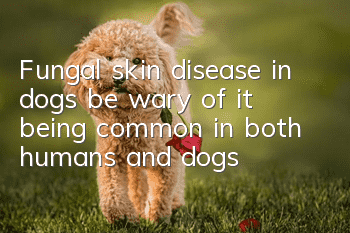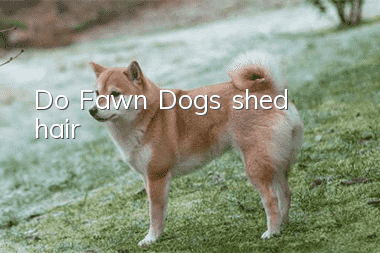Fungal skin disease in dogs, be wary of it being common in both humans and dogs

Dogs are very cute and loyal friends of humans. If trained well, they will become their owners' right-hand assistants. When dogs are old, weak, sick, or disabled, they are easily infected with fungal skin diseases. Dogs during this period need more care from their owners!
Canine fungal skin diseases are fungi that parasitize in the dog's coat, epidermis, and keratin tissues of toes and claws and multiply in large quantities, causing a series of organic lesions in the local skin. It is one of the most common infectious skin diseases in dogs.
Fungal skin diseases mostly occur in young dogs, old dogs and dogs with weak constitution and low body resistance. Symptoms include hair loss, round spots, itching, scales, and scabs on the skin. Fungi that cause skin infections in dogs mainly include Microsporum canis, Microsporum gypseum, and Trichophyton mentagrophytes. The spread of canine fungal diseases is mostly through contact and is a zoonotic infectious disease with no obvious seasonal factors.
Five species of mold have been found to cause skin mycosis in dogs: Microsporum canis, Microsporum gypseum, Trichophyton mentagrophytes, Microsporum audouinii and Microsporum proteus.
Be wary of artificially creating the most suitable living environment for fungi
The incidence rate is higher in hot and humid climates. Factors such as high air humidity, humid living environment, uncleanness, and frequent failure to blow or dry after bathing all create a good adaptable environment for the survival of fungi.
Young animals are more susceptible to infection than adult animals. Puppies or old dogs have low body resistance and do not have more immunity to fight fungi, which allows fungi to take advantage of them.
Those who are malnourished and weak are more susceptible to infection than those who are nutritionally strong. Those who do not eat dog food for a long time or eat low-priced dog food, as well as long-term bad feeding habits such as eating meat and animal livers, will all cause unbalanced nutritional intake of dogs and lead to internal body diseases. Lack of vitamins and trace elements leads to decreased resistance, resulting in fungal infections that are difficult to recover from.
Frequently cleaning the dog's coat too much, or frequently using alkaline shower gel to bathe the dog, will destroy the protective layer of oil on the dog's skin.
There are several types of fungi with different symptoms
1. Microsporum canis:
More than 70% of canine ringworm cases are caused by it, and a variety of animals and people can be infected. The main lesions are small round scabs (ringworm) formed on the skin surface. This kind of localized scab skin lesions can appear on any part of the dog, but the ears, face, neck and tail are the most common. This type of lesions, which are mainly skin scabs, are often not accompanied by hair loss. When there are not many lesions, especially when they occur in long-haired dogs, they are often not discovered. Microsporum canis mainly causes tinea capitis in humans.
2. Microsporum gypsum:
Living in the soil, it can cause skin mycosis in dogs and other animals and humans. The onset of this disease is rapid and the damage is severe. The site of occurrence is similar to that of Microsporum. In addition to round pimples, it sometimes causes large-area skin lesions. The coat of the lesion falls off, and dandruff and scabs appear. When secondary bacterial infection occurs, exudative suppuration occurs locally. It can last for months or even years after it becomes chronic.
3. Microsporum audouinii and Trichophyton mentagrophytes:
Canine skin mycosis caused by these two bacteria is rare. These two molds can also infect people. The former mainly causes tinea capitis in children, and the latter is the main pathogen of athlete's foot in the United States. Dogs usually become infected through contact with sick people.
Fungal skin diseases are highly contagious
Fungi have extremely strong vitality and resistance. They can parasitize animals and plants or be spread in the air with dust, giving them many opportunities for spread. It can be transmitted through direct contact, but indirect infection can also occur through contact with contaminated utensils, combs, scissors, bedding, etc. It can be transmitted between animals and between humans and dogs.
Be sure to blow dry after bathing!
Many owners will give their dogs a bath at home, but fail to dry the dog’s coat in time after washing. Or because you are not professional and do not blow dry the coat completely, especially for dogs with double coats, the undercoat is not easy to dry, which will cause safety hazards to the skin and create space for fungi to survive and adapt to the environment.
For dogs with long beards and big ears, sometimes eating and drinking will get their mouths or ears wet and dirty. Pay attention to cleaning them in time to keep their hair dry and tidy.
Treatment of fungal skin diseases, two steps are the most critical
Taking medicated baths and spraying medicine
Take medicated baths on time, wash, soak, massage, rinse with cleansing bath liquid first, wash off dandruff and scabs, clean up the shed and broken coat, and then apply medicated bath liquid all over the body to avoid the spread of fungi. Massage the affected area for 10 minutes, soak for 10 minutes, and then rinse. It should be noted that you need to blow dry after washing, especially the undercoat. Apply antiseptic medicine to the affected area every morning and evening, and take a fungal medicated bath until it is completely healed.
Strengthen nutritional supplements
At the same time, pay attention to strengthening nutrition, including enough protein in the diet, and paying attention to supplementing various vitamins, minerals and trace elements to enhance the body's resistance. Pay attention to grooming the coat, keeping it clean and preventing scratches. If you keep pets properly, dogs will rarely have such a situation. Prevention is better than cure. I hope you all will, can be a good guardian of the dog, so that the dog can avoid pain and suffering!
- Teach you how to listen to your dog’s voice
- How to treat pyrozoonosis in dogs
- Do you know Alaskan Huskies? Are they easy to raise?
- Why does the puppy sleep every day?
- Why does my dog’s belly feel so hot?
- Reasons why dogs grow too slowly
- Symptoms and treatments for colds in dogs
- How to care for your dog’s face? Three Steps to Dog Facial Care
- What are the benefits of eating grain-free dog food for dogs?
- What to do if a puppy is bitten by a big dog



